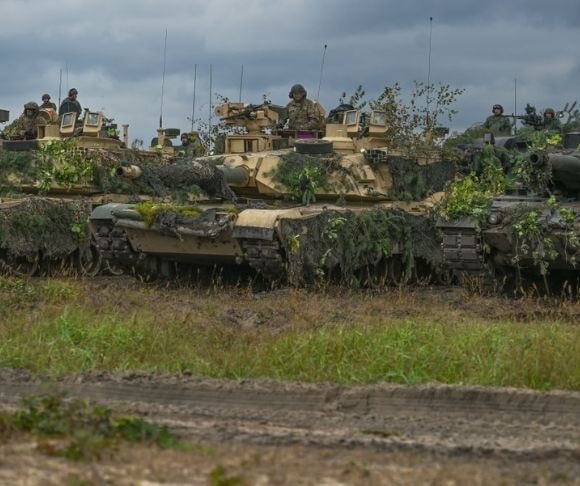Following a January 20 meeting of the NATO allies and friends of Ukraine at Ramstein Air Base, Germany, Secretary of Defense Lloyd Austin III debriefed the press corps on the eighth in a series of Ukraine Defense Contact Group discussions. The conference had as its primary agenda item increasing the military support to the Kyiv government, specifically whether modern tanks are among the weapons to be provided. Would the US, NATO allies – and especially Germany – pony up main battle tanks like the German Leopard 2 and US Abrams M1-A1 for Ukraine?
 When asked about the tank issue, Secretary Austin said, “Poland, for example, is… continues to offer tanks and will provide tanks, and other countries will offer some tank-capability, as well. I don’t have any announcements to make on M1s.” To date, the US has not offered the Abrams M1-A1. Leopard 2 became a hot topic during the Ukraine Defense Contact Group deliberations because, in the view of many of the 50 nations participating in the conference, the German tanks are more readily available. Additionally, Ukrainian soldiers would be more quickly trained on Leopard 2’s in preparation for any Russian Spring counteroffensive.
When asked about the tank issue, Secretary Austin said, “Poland, for example, is… continues to offer tanks and will provide tanks, and other countries will offer some tank-capability, as well. I don’t have any announcements to make on M1s.” To date, the US has not offered the Abrams M1-A1. Leopard 2 became a hot topic during the Ukraine Defense Contact Group deliberations because, in the view of many of the 50 nations participating in the conference, the German tanks are more readily available. Additionally, Ukrainian soldiers would be more quickly trained on Leopard 2’s in preparation for any Russian Spring counteroffensive.
Germany Not a Hard No on Leopard Tanks
The new German Minister of Defense, Boris Pistorius, did not issue a hard no on providing the Leopards, more like a definite maybe. To that point, Austin told reporters, “…and you heard the German minister of defense say they’ve not made a decision on the Leopards.” Nonetheless, many at the conference were not bashful in attempting to persuade Germany to provide its frontline tank. As The New York Times reported:
“The pressure was coming from several quarters. In a joint statement on Twitter, the foreign ministers of Estonia, Latvia, and Lithuania urged Germany to ‘provide Leopard tanks to Ukraine now.’ They added: ‘This is needed to stop Russian aggression, help Ukraine and restore peace in Europe quickly. Germany, as the leading European power, has special responsibility in this regard.'”
Countries already owning Leopard 2 tanks are proscribed from exporting those tanks without authorization. “At the center of the roadblock is Germany, which needs to give permission to other countries that possess the tank before they can export it to Ukraine,” The Hill reported. The Polish government is leaning toward providing the German tanks it possesses. “Polish Defense Minister Mariusz Blaszczak, whose country has pledged 14 Leopard tanks should other countries also hand them over, said he was optimistic on progress after the ministers of 15 countries met on the sidelines of the conference to discuss the topic,” Mitchell continued.
Still a Lot of Weapons Pledged to Ukraine

(Photo by Artur Widak/NurPhoto via Getty Images)
Despite the problem of Germany not being as forthcoming as the other participants might have liked, the importance of supporting Ukraine was never in question. Among the weapons included in the US $2.5 billion military aid package, announced just before the conference, Austin listed “59 additional Bradley infantry fighting vehicles and 90 Stryker armored personnel carriers, 53 MRAPs and 350 up-armored Humvees, and … thousands more rounds of artillery.” Additionally, as part of “The Tallinn Pledge,” a host of other countries offered up an impressive list of weapons to be provided to Ukraine. The Defense Ministers of the Czech Republic, United Kingdom, Poland, Latvia, Lithuania, and Denmark agreed to provide a vast array of helicopters, artillery, anti-tank weapons, ammunition, and hundreds of millions in Euros.
However, a question not getting much attention amid the tank debate is just how vital tanks are on the Ukraine battlefield. Unquestionably, the behemoth war machines are impressive in tank-on-tank heavy gun battles. But such combat engagements aren’t as likely as the more frequent tank bombardments of artillery and infantry fighting positions. Furthermore, with the ubiquity of modern anti-tank weapons, from unmanned aerial vehicles or tank-destroying ground-fired missiles like the Javelin, the efficacy of even modern tanks could be reduced. Instead, rapid movement and agility may be the more valuable capability. Regardless, tanks are a symbol of power that cannot be ignored.
A much more troubling result of the recent Ukraine Contact Group meeting is the failure to resolve this thorny matter that has the potential to be divisive in the long term. This roadblock in what had been touted as great unity among the allies would benefit from an early resolution. Many will look to US leadership. Will it be there?
The views expressed are those of the author and not of any other affiliation.




